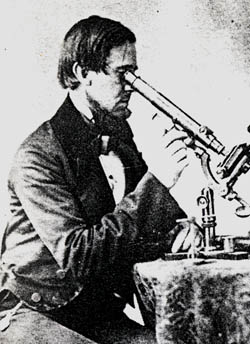<Back to Index>
- Natural Philosopher and Photographer Hamilton Lanphere Smith, 1819
PAGE SPONSOR

Hamilton Lanphere Smith (November 5, 1819 - 1903) was an American scientist, photographer, and astronomer.
He was born in New London, Connecticut, and graduated from Yale in 1839, where he constructed the largest telescope in the country at the time in 1838.
In 1848 Smith wrote "The World", one of the first science textbooks written in America. Smith is best known for patenting the tintype photographic process, which popularized photography in America. He patented the great American tintype on February 19, 1856.
Between 1853 and 1868 he was Professor of Natural Philosophy and
Astronomy at Kenyon College, Gambier, Ohio, and later taught at Hobart
College in New York. He also created a system for describing microscopic
algae that is still in use today.
Tintype, also melainotype and ferrotype, is a photograph made by creating a direct positive on a sheet of iron metal that is blackened by painting, lacquering or enameling and is used as a support for a collodion photographic emulsion.
Photographers usually worked outside at fairs, carnivals etc. and as the support of the tintype (there is no actual tin used) is resilient and does not need drying, photographs can be produced only a few minutes after the picture is taken.
An ambrotype uses the same process and methods on a sheet of glass
that is mounted in a case with a black backing so the underexposed
negative image
appears as a positive. Tintypes did not need mounting in a case and
were not as delicate as photographs that used glass for the support.
The process is very similar to wet plate photography, where silver halide crystals (silver bromide, silver chloride and silver iodide) are suspended in a collodion emulsion that is chemically reduced to crystals of metallic silver that vary in density in accordance with variations in the intensity and duration of light impinging on the emulsion.
In a tintype, a very underexposed negative image is produced on a thin iron plate, lacquered or otherwise darkened, and coated with a collodion photographic emulsion. Since in a negative image the darker portions of the subject appear lighter, or in this case more transparent, the dark background gives the resulting image the appearance of a positive. The ability to employ underexposed images allows effective film speed to be increased, permitting shorter exposure time, a great advantage in portraiture.
One unique piece of equipment was a twelve lens camera that could take a dozen 3/4" x 1" "gem - sized" portraits in one exposure. Portrait sizes ranged from gem - sized to 11" x 14". From about 1865 to 1910 the most popular size, called "Bon-ton", ranged from 2-3/8" x 3-1/2" to 4" x 5-3/4".
The process was first described by Adolphe - Alexandre Martin in France in 1853, patented in 1856 both in the United States by Hamilton Smith and William Kloen in the United Kingdom. It was first called melainotype, then ferrotype by a rival manufacturer of the iron plates used; finally tintype.
The ambrotype was the first wet plate collodion process, invented by Frederick Scott Archer in 1851 and introduced in the United States by James Ambrose Cutting in 1854.
While the ambrotype remained very popular in the rest of the world, the
tintype process had superseded the ambrotype in the United States by the
end of the Civil War. It became the most common photographic process
until the introduction of modern, gelatin based processes and the
invention of the reloadable amateur camera by the Kodak company.
Ferrotypes had waned in popularity by the end of the 19th
century, although a few makers were still around as late as the 1950s
and the images are still made as novelties at some European carnivals.
The tintype was a minor improvement to the ambrotype, replacing the glass plate of the original process with a thin piece of black - enameled, or japanned, iron (hence ferro). The new materials reduced costs considerably; and the image, in gelatin - silver emulsion on the varnished surface, has proven to be very durable. Like that of the ambrotype, the tintype's image is technically negative; but, because of the black background, it appears as a positive. Since the tintype 'film' was the same as the final print, most tintype images appear reversed (left to right) from reality. Some cameras were fitted with mirrors or a 45 degree prism to reverse (and thus correct) the image, while some photographers would photograph the reversed tintype to produce a properly oriented image.
Tintypes are simple and fast to prepare, compared to other early photographic techniques. A photographer could prepare, expose, develop and varnish a tintype plate in a few minutes, quickly having it ready for a customer. Earlier tintypes were often cased, as were daguerreotypes and ambrotypes; but uncased images in paper black sleeves and for albums were popular from the beginning.
Ferrotyping is a finishing treatment applied to glossy photographic paper to bring out its reflective properties. Newly developed, still - wet photographic prints and enlargements that have been made on glossy paper are squeegeed onto a polished metal plate called a ferrotyping plate. When these are later peeled off the plate, they retain a highly reflective gloss.